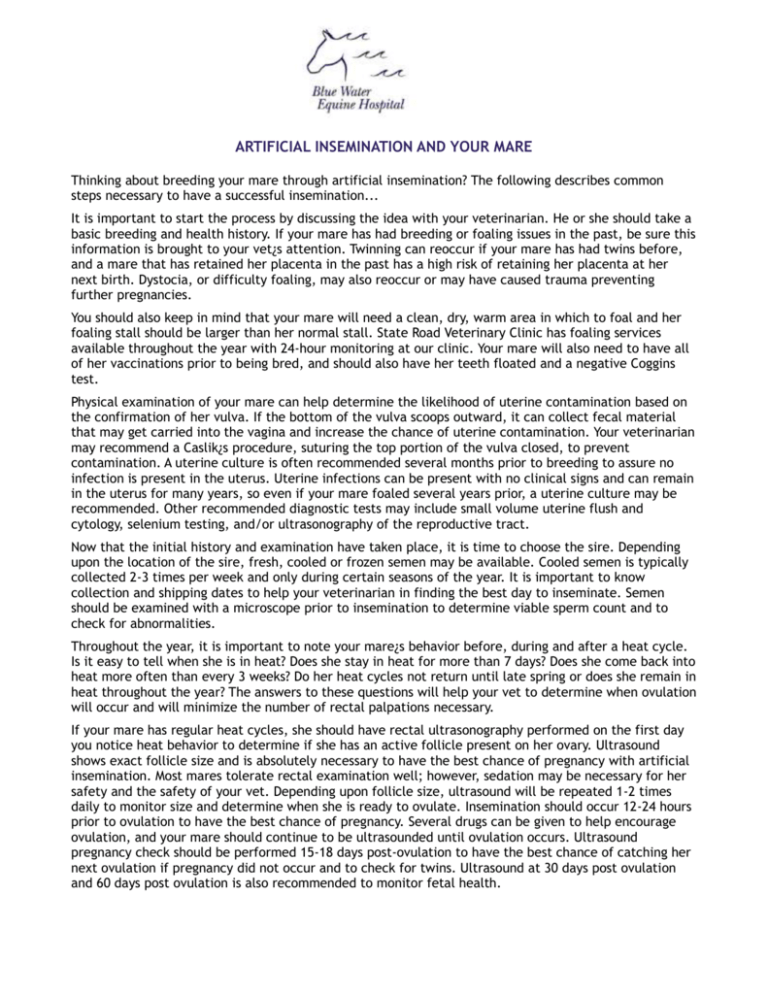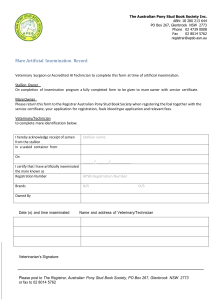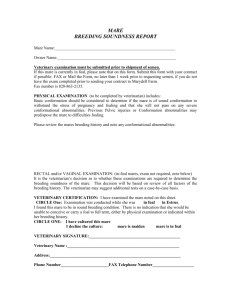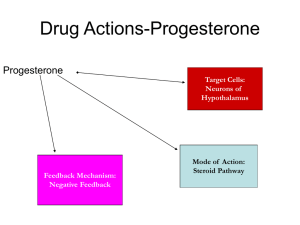Artificial Insemination - Blue Water Equine Hospital
advertisement

ARTIFICIAL INSEMINATION AND YOUR MARE Thinking about breeding your mare through artificial insemination? The following describes common steps necessary to have a successful insemination... It is important to start the process by discussing the idea with your veterinarian. He or she should take a basic breeding and health history. If your mare has had breeding or foaling issues in the past, be sure this information is brought to your vet¿s attention. Twinning can reoccur if your mare has had twins before, and a mare that has retained her placenta in the past has a high risk of retaining her placenta at her next birth. Dystocia, or difficulty foaling, may also reoccur or may have caused trauma preventing further pregnancies. You should also keep in mind that your mare will need a clean, dry, warm area in which to foal and her foaling stall should be larger than her normal stall. State Road Veterinary Clinic has foaling services available throughout the year with 24-hour monitoring at our clinic. Your mare will also need to have all of her vaccinations prior to being bred, and should also have her teeth floated and a negative Coggins test. Physical examination of your mare can help determine the likelihood of uterine contamination based on the confirmation of her vulva. If the bottom of the vulva scoops outward, it can collect fecal material that may get carried into the vagina and increase the chance of uterine contamination. Your veterinarian may recommend a Caslik¿s procedure, suturing the top portion of the vulva closed, to prevent contamination. A uterine culture is often recommended several months prior to breeding to assure no infection is present in the uterus. Uterine infections can be present with no clinical signs and can remain in the uterus for many years, so even if your mare foaled several years prior, a uterine culture may be recommended. Other recommended diagnostic tests may include small volume uterine flush and cytology, selenium testing, and/or ultrasonography of the reproductive tract. Now that the initial history and examination have taken place, it is time to choose the sire. Depending upon the location of the sire, fresh, cooled or frozen semen may be available. Cooled semen is typically collected 2-3 times per week and only during certain seasons of the year. It is important to know collection and shipping dates to help your veterinarian in finding the best day to inseminate. Semen should be examined with a microscope prior to insemination to determine viable sperm count and to check for abnormalities. Throughout the year, it is important to note your mare¿s behavior before, during and after a heat cycle. Is it easy to tell when she is in heat? Does she stay in heat for more than 7 days? Does she come back into heat more often than every 3 weeks? Do her heat cycles not return until late spring or does she remain in heat throughout the year? The answers to these questions will help your vet to determine when ovulation will occur and will minimize the number of rectal palpations necessary. If your mare has regular heat cycles, she should have rectal ultrasonography performed on the first day you notice heat behavior to determine if she has an active follicle present on her ovary. Ultrasound shows exact follicle size and is absolutely necessary to have the best chance of pregnancy with artificial insemination. Most mares tolerate rectal examination well; however, sedation may be necessary for her safety and the safety of your vet. Depending upon follicle size, ultrasound will be repeated 1-2 times daily to monitor size and determine when she is ready to ovulate. Insemination should occur 12-24 hours prior to ovulation to have the best chance of pregnancy. Several drugs can be given to help encourage ovulation, and your mare should continue to be ultrasounded until ovulation occurs. Ultrasound pregnancy check should be performed 15-18 days post-ovulation to have the best chance of catching her next ovulation if pregnancy did not occur and to check for twins. Ultrasound at 30 days post ovulation and 60 days post ovulation is also recommended to monitor fetal health.








